, A1_x468.jpg)
, A2_x468.jpg)
, A3_x468.jpg)
, A4_x468.jpg)
, A5_x468.jpg)
, A6_x468.jpg)
, A7_x468.jpg)
, A8_x300.jpg)
, MU, A9_x300.jpg)
, MU, A10_x300.jpg)
, MU, A11_x300.jpg)
, A12_x300.jpg)
, A13_x300.jpg)
, MU, A15_x300.jpg)
, MU, A16_x300.jpg)
, MU, A17_x300.jpg)
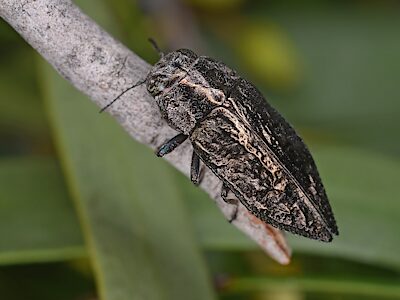
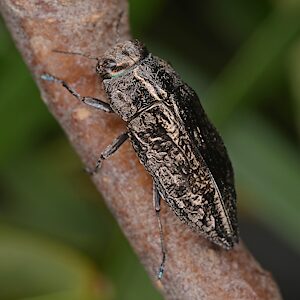
size¹:
×
5.0 mm
, A1_x468.jpg)
, A2_x468.jpg)
, A3_x468.jpg)
, A4_x468.jpg)
, A5_x468.jpg)
, A6_x468.jpg)
, A7_x468.jpg)
, A8_x300.jpg)
, MU, A9_x300.jpg)
, MU, A10_x300.jpg)
, MU, A11_x300.jpg)
, A12_x300.jpg)
, A13_x300.jpg)
, MU, A15_x300.jpg)
, MU, A16_x300.jpg)
, MU, A17_x300.jpg)


| male | female | |||||
|---|---|---|---|---|---|---|
| L1 | 11.6 | 11.35 – 11.8 | n = 4 | 12.9 | 12.45 – 13.2 | n = 3 |
| L2 | 11.3 | 11 – 11.55 | n = 4 | 12.7 | 12.25 – 12.9 | n = 3 |
| W | 4.8 | 4.8 – 4.8 | n = 4 | 5.2 | 5 – 5.35 | n = 3 |
| Legend | L1 | length from clypeus/frons to elytral apex (mean, range, sample size) |
| L2 | length from anterior of edge of eyes to elytral apex | |
| W | maximum width with elytra fully closed |
Surface of elytra irregularly crinkled and glabrous. Colouration dark bronze-grey with silvery reflections. Short, broad convex shape.
This early-emerging species was confirmed for SA in September 2022 when I reared the first adults from billets collected north of Renmark. Until then it had been included on these pages only as a probable occurrence with the following comment. 'Although attributed to SA on the Australian Fauna Directory, no definite records from SA have been ascertained. However, it is almost certain to occur here given recent collections in north-western Victoria from a host plant and habitat type that are both well represented in SA.'
In north-western Victoria it was first collected in 1922 from Linga which is only 67 km east from the SA border. In September 2020 it was 'rediscovered' by Fiona and Phil Murdoch at a site south of Mildura and about 130 km east of the SA border.
The Holotype specimen is purportedly from Israelite Bay in WA, and its occurrence there needs verification.
| Legend | P.J.Lang collection vouchered records | |
| other private collection or museum specimens, or sightings |
|
|
|
|
|
|
|
|
|
|
|
|
|
||||||||||||||||||||||||||||||||||||||||||||||||
|
|
|
|
|
|
|
|
|
|
|
|
|
||||||||||||||||||||||||||||||||||||||||||||||||
| Jul | Aug | Sep | Oct | Nov | Dec | Jan | Feb | Mar | Apr | May | Jun |
| Legend | live emerged adults, count > median value of 3 per quarter month | |
| live emerged adults, count <= median value of 3 | ||
| live non-emerged adults only, for that quarter month | ||
12 | number of active beetles for that quarter month |
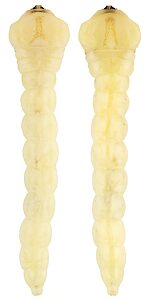
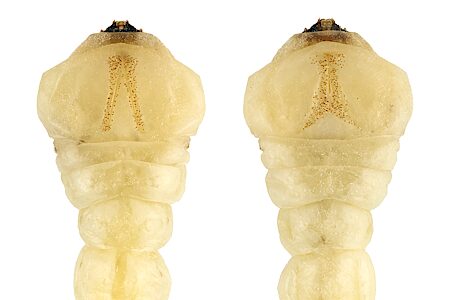
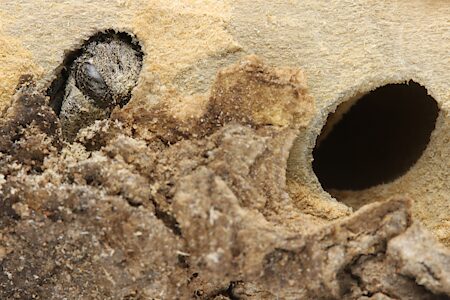
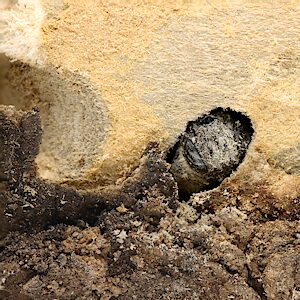
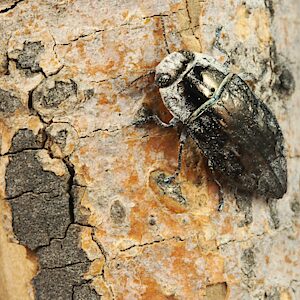
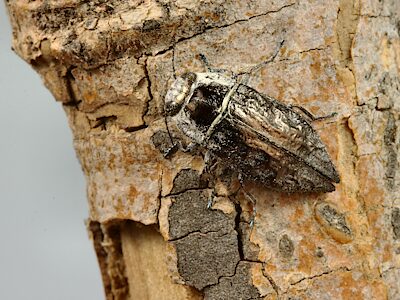
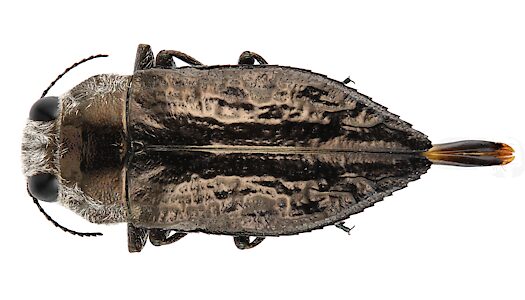
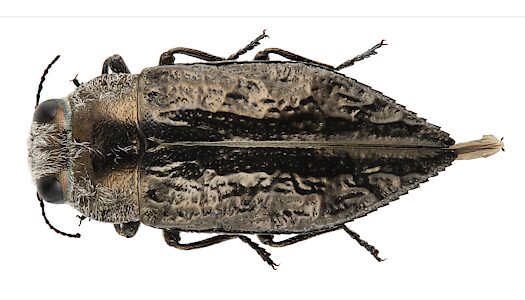
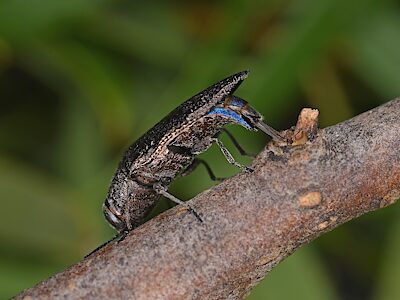
| records | sites | SA regions¹ | family | adult dead | adult ex billet | adult ex pupa | larva | |
| Pittosporum angustifolium | 12 | 1 | MU | P | 2 | 4 | 1 | 5 |
| Legend | records | count of breeding adults, pupae and larvae |
| sites | count of major sites (unique 10 km grid cells +/- some distinct approximate localities) | |
| adult | live = extracted alive; dead = extracted dead as intact or fragmentary remains; ex billet = reared and emerged from stored sections of host; ex pupa = reared from sampled pupa | |
| pupa | extracted pupa; pupa ex larva = reared pupa from larva | |
| larva | extracted larva (any stage including prepupa) | |
| gall (only) | hatched or unhatched gall identified by form and position rather than contents | |
| Plant names in green are hyperlinked to a matching host species page with plant photos. | ||
| Code | records | % | host plant taxa | |
| P | Pittosporaceae | 12 | 100% | 1 |
| position | records | sites | adult dead | adult ex billet | adult ex pupa | larva | |
| dead stem | 12 | 1 | 2 | 4 | 1 | 5 |
Recent collections from north-western Victoria (A.M. Sundholm, 2020, pers. comm.) establish Native Apricot Pittosporum angustifolium) as an adult host.
The role of P. angustifolium as a larval host is indicated by Sundholm’s observation of a specimen in captivity ovipositing on stems (see image above), confirmed by sightings of the eggs. This is now attested by the 7 adults that I extracted or reared from billets obtained from the lower trunks of two adjacent dead P. angustifolium saplings. The billets had 19 preexisting exit holes of matching size and shape, indicating emergence of M. abnormis in the preceding season.
Wilson 1936 reported cutting a single dead adult of this species from the trunk of a 'sandalwood tree' in 1922 on the shores of a salt lake in the centre of the Little Desert to the south of Kiata, Vic. There is a corresponding specimen in the National Museum of Victoria (from Linga) and its identity as M. abnormis is not in doubt. Based on the usual application of the common name ‘sandalwood’ mentioned by Wilson 1936 (and also written on the specimen label), the breeding host was presumed to be a species of Santalum, with Quandong, S. acuminatum considered the most likely candidate. However, as the 2020 adult collections were from P. angustifolium, and this is a small tree of similar appearance to Santalum in its habit and foliage shape, it seems more likely that Wilson was referring to the latter species in his ‘sandalwood tree’ reference.
| ¹ Legend | regions | SA State Herbarium regions (map) EA: Eastern, EP: Eyre Peninsula, FR: Flinders Ranges, GT: Gairdner-Torrens, KI: Kangaroo Island, LE: Lake Eyre, MU: Murray, NL: Northern Lofty, NU: Nullarbor, NW: North-Western, SE: South-Eastern, SL: Southern Lofty, YP: Yorke Peninsula |
| size | The ellipse is the correct size when printed, indicative on a desktop screen, and likely to be wrong on a mobile device. |